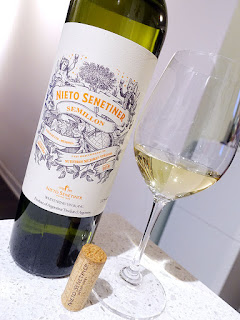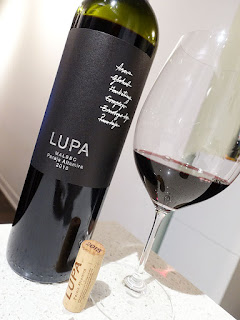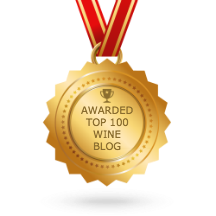red wine review is this delicious Cabernet Sauvignon from Argentina that arrived at the LCBO recently as part of the feature on wines from Argentina in the LCBO VINTAGES Release.
This red wine is produced by Bodega Luigi Bosca, Argentina's oldest family-run winery. It was founded in 1901 by Leoncio Arizu and soon after joined forces with the Bosca family that emigrated from Piamonte, Italy, to form Bodega Luigi Bosca - Arizu Family. Celebrating it's 120th anniversary last year, Luigi Bosca is regarded as one of Argentina's pioneers in winemaking. Luigi Bosca helped establish Argentina's first D.O.C., paving the way for the development of new Geographical Indications (GIs) throughout Mendoza. Today, the historic Luigi Bosca is run by the fourth generation of the Arizu family based in Mendoza's original premium zone - Lujàn de Cuyo.
Cabernet Sauvignon is the third most planted red variety in Argentina with more than 35,000 acres planted, representing approximately 12% of all red varieties. More than three-quarters of all Cabernet Sauvignon planted within the country is in Mendoza, with Maipú and Luján de Cuyo the historical regions with older vines - and also where this wine is from. The Maipú sub-zone is located on the southern outskirts of Mendoza City, dominated by flat vineyards at high-altitudes, while Luján de Cuyo is situated just west of Maipú and south of Mendoza City. Cabernet Sauvignon is also one of the most researched varieties in Argentina, and the majority of new plantings are located in the premium growing zones, such as the Uco Valley. In Maipú and Luján de Cuyo, the climate is warm and dry, helping Cabernet ripen and give it an intense and voluptuous style with good body and structure. In Maipú, Cabernet has a classic profile of black fruits and spices, while in Luján de Cuyo, with its deep silty, clay, and sandy soils, delivers good varietal typicity reminiscent of black fruits and a broad, rounded palate.
This particular Cabernet Sauvignon was crafted with grapes grown in Luigi Bosca's own vineyards located in Maipú and Luján de Cuyo. This Cabernet Sauvignon comes from vines that are on average 40-years-old. The grapes were manually harvested, bunch selected, and de-stemmed, followed by fermentation in stainless steel. After ageing for 14 months in French and American oak barrels, the wine is gently filtered and bottled. The 2019 vintage is considered excellent with a slightly cooler than normal growing season resulting in concentrated and balanced wines, albeit with yields slightly lower than normal. Let's see how this 2019 Cabernet Sauvignon from Argentina is tasting tonight...
100% Cabernet Sauvignon from 40-year-old vines grown between 800 to 1,000 metres (2,600 to 3,200 feet) elevation. The fresh, medium-high intensity nose is black fruited with dark currant, spice, and woody aromas with a hint of vanilla. On the medium-full bodied palate, it has delicious ripe black and red fruits, currant, cassis, spices, and wood flavours supported by fresh acidity. Structured tannins are smooth and refined. Spiced wood notes linger on the crisp, juicy finish, with very good length. Recommended buy. Score: 88 pts
Other delicious wines from Luigi Bosca are available at the LCBO and through their Agent - FWM Canada.
This red wine is produced by Bodega Luigi Bosca, Argentina's oldest family-run winery. It was founded in 1901 by Leoncio Arizu and soon after joined forces with the Bosca family that emigrated from Piamonte, Italy, to form Bodega Luigi Bosca - Arizu Family. Celebrating it's 120th anniversary last year, Luigi Bosca is regarded as one of Argentina's pioneers in winemaking. Luigi Bosca helped establish Argentina's first D.O.C., paving the way for the development of new Geographical Indications (GIs) throughout Mendoza. Today, the historic Luigi Bosca is run by the fourth generation of the Arizu family based in Mendoza's original premium zone - Lujàn de Cuyo.
Cabernet Sauvignon is the third most planted red variety in Argentina with more than 35,000 acres planted, representing approximately 12% of all red varieties. More than three-quarters of all Cabernet Sauvignon planted within the country is in Mendoza, with Maipú and Luján de Cuyo the historical regions with older vines - and also where this wine is from. The Maipú sub-zone is located on the southern outskirts of Mendoza City, dominated by flat vineyards at high-altitudes, while Luján de Cuyo is situated just west of Maipú and south of Mendoza City. Cabernet Sauvignon is also one of the most researched varieties in Argentina, and the majority of new plantings are located in the premium growing zones, such as the Uco Valley. In Maipú and Luján de Cuyo, the climate is warm and dry, helping Cabernet ripen and give it an intense and voluptuous style with good body and structure. In Maipú, Cabernet has a classic profile of black fruits and spices, while in Luján de Cuyo, with its deep silty, clay, and sandy soils, delivers good varietal typicity reminiscent of black fruits and a broad, rounded palate.
This particular Cabernet Sauvignon was crafted with grapes grown in Luigi Bosca's own vineyards located in Maipú and Luján de Cuyo. This Cabernet Sauvignon comes from vines that are on average 40-years-old. The grapes were manually harvested, bunch selected, and de-stemmed, followed by fermentation in stainless steel. After ageing for 14 months in French and American oak barrels, the wine is gently filtered and bottled. The 2019 vintage is considered excellent with a slightly cooler than normal growing season resulting in concentrated and balanced wines, albeit with yields slightly lower than normal. Let's see how this 2019 Cabernet Sauvignon from Argentina is tasting tonight...
Tasting Note:
LUIGI BOSCA CABERNET SAUVIGNON 2019 - Maipú & Luján de Cuyo, Mendoza, Argentina (#128629) (XD) - $18.95100% Cabernet Sauvignon from 40-year-old vines grown between 800 to 1,000 metres (2,600 to 3,200 feet) elevation. The fresh, medium-high intensity nose is black fruited with dark currant, spice, and woody aromas with a hint of vanilla. On the medium-full bodied palate, it has delicious ripe black and red fruits, currant, cassis, spices, and wood flavours supported by fresh acidity. Structured tannins are smooth and refined. Spiced wood notes linger on the crisp, juicy finish, with very good length. Recommended buy. Score: 88 pts
Other delicious wines from Luigi Bosca are available at the LCBO and through their Agent - FWM Canada.






























